
Peru was one of the most important countries to emerge from the breakup of the Spanish colonial empire in South America. In theory he should field one of the strongest armies as well. But the political game of power did not allow such a thing and when the need arose the army was unprepared.
The War of the Pacific of 1879-83, with Peru and Bolivia fighting together against Chile, broke out for purely economic reasons, for the exploitation of the mineral-rich Atacama desert, and the Andes region on the current borders of the three countries. The war began with the invasion of the Chilean army into lands that then belonged to Bolivia which declared war on Chile, which responded by declaring war on Peru, which was an ally of Bolivia.
Peru was not prepared for such a matchup. Torn for years by political strife that took the form of civil wars, it had a very small regular army of 6,140 men at its disposal. This number included 25 generals and 2,654 other officers. It therefore corresponded to about one officer for every 1.4 men!
The infantry consisted of only eight battalions. There were still three cavalry regiments and two artillery regiments, all undermanned. The infantry battalions were the 1st from the province of Picinca, which today belongs to Ecuador, the 2nd from the province of Zepita, the 3rd from the region of Ayacucho, the 4th from the city of Callao, the 5th Hunters of Cusco, the 6th Hunters of Puno, the 7th Hunters of the Guard and the 8th of the capital Lima.
Together with a regiment of lancers, a regiment of hussars and a regiment of cavalry and two regiments of artillery, they formed the “Army of the South” . Eight more infantry battalions and many more national guard battalions were formed during the war.
In 1880 the infantry extended to 16 battalions of the line, seven battalions of national guards and five "phalanxes" of national guards, also of battalion strength. A marine battalion of six companies was also formed. After the disastrous defeats in Tacna and Arica there was a new reorganization to contain the Chileans before Lima. All able-bodied men aged 16-60 were conscripted into the army, forming the Reserve Army of Lima.
Thus they gathered about 20,000 men. However, this force had huge shortages in armaments and equipment and of course the men were not sufficiently trained. Theoretically the infantry came to line up 30 regular battalions and 41 battalions or battalions of national guards. However, the Chilean Army could not be restrained and Lima was conquered.
Many officers and soldiers of the disbanded army fled to the Andes and formed a force known as the "Army of the Center". It was joined by many Indians who carried out guerilla warfare attacks against the Chileans. Another force that was formed from remnants of units was the so-called "Army of the North", but it did not have many successes to show. The Peruvians were forced to admit defeat and signed an initial treaty with Chile in 1883. The war officially ended in April 1884.
The Peruvian infantryman was, according to the confession of his opponents, a brave soldier. However, he was not well trained, while he also lagged behind his opponents in terms of armament. Thus the regular infantry was annihilated in the first battles and from 1880 onwards the infantry units were made up of even less trained men, who were hastily recruited in anticipation of the enemy's advance. The National Guard received even worse training and were armed with whatever weapon was available.
The same and worse applied to the training and equipment of the men of the so-called "Reserve Army of Lima". Most of her men were Indian tenants of the landowners and had little interest in the conflict. On the contrary, the men who were rescued and took refuge in the Andes were the most determined and fought well reinforced by the Cuesca Indians, who, accustomed to the wild climate of the mountain range, proved indefatigable against the Chileans.
The infantry was armed with a variety of weaponry. There were 5,000 Belgian-made French Chassepot rifles , but also newer Chassepot model 1869 with metal cartridge and 2,000 Comblain rifles . It was decided to convert 5,000 Chassepots to fire the 11mm Comblain cartridge, but only 2,000 of these were converted.
When war broke out the infantry still had 1,417 converted front-loading Snider-Enfield M1866 rifles . Peabody-Martini rifles were ordered during the war from Turkey, and made by Remington in Spain . Another 5,000 Remingtons were purchased from Egypt. In general the infantry were plagued by the multiplicity and antiquity and poor maintenance of their rifles.
